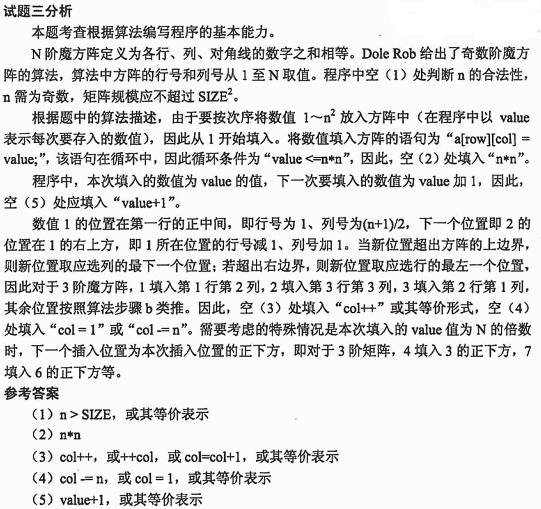阅读下列函数说明和C函数,将应填入(n)处的字句写对应栏内。[说明]二叉树的二叉链表存储结构描述如下:typedef struct BiTNode{ datatype data;struct BiTNode *lchild, * rchild; /*左右孩子指针*/}BiTNode,* BiTree;对二叉树进行层次遍历时,可设置一个队列结构,遍历从二叉树的根结点开始,首先将根结点指针入队列,然后从队首取出一个元素,执行下面两个操作:(1) 访问该元素所指结点;(2) 若该元素所指结点的左、右孩子结点非空
题目
阅读下列函数说明和C函数,将应填入(n)处的字句写对应栏内。
[说明]
二叉树的二叉链表存储结构描述如下:
typedef struct BiTNode
{ datatype data;
struct BiTNode *lchild, * rchild; /*左右孩子指针*/
}BiTNode,* BiTree;
对二叉树进行层次遍历时,可设置一个队列结构,遍历从二叉树的根结点开始,首先将根结点指针入队列,然后从队首取出一个元素,执行下面两个操作:
(1) 访问该元素所指结点;
(2) 若该元素所指结点的左、右孩子结点非空,则将该元素所指结点的左孩子指针和右孩子指针顺序入队。
此过程不断进行,当队列为空时,二叉树的层次遍历结束。
下面的函数实现了这一遍历算法,其中Visit(datatype a)函数实现了对结点数据域的访问,数组queue[MAXNODE]用以实现队列的功能,变量front和rear分别表示当前队首元素和队尾元素在数组中的位置。
[函数]
void LevelOrder(BiTree bt) /*层次遍历二叉树bt*/
{ BiTree Queue[MAXNODE];
int front,rear;
if(bt= =NULL)return;
front=-1;
rear=0;
queue[rear]=(1);
while(front (2) ){
(3);
Visit(queue[front]->data); /*访问队首结点的数据域*/
if(queue[front]—>lchild!:NULL)
{ rear++;
queue[rear]=(4);
}
if(queue[front]->rchild! =NULL)
{ rear++;
queue[rear]=(5);
}
}
}
相似考题
更多“阅读下列函数说明和C函数,将应填入(n)处的字句写对应栏内。[说明] 二叉树的二叉链表存储结构描述 ”相关问题
-
第1题:
阅读以下说明和C语言函数,将应填入(n)处的语句写在对应栏内。
【说明】
下面的程序构造一棵以二叉链表为存储结构的二叉树。
【函数】
BitTree *createbt(BitTree *bt)
{
BitTree *q;
struct node *s[30];
int j,i;
char x;
printf("i,x=");
scant("%d,%c",&i,&x);
while(i!=0 && x!='$')
{
q=(BitTree *}malloc(sizeof(BitTree));//生成一个结点
(1);
q->lchild=NULL;
q->rchild=NULL;
(2) ;
if ((3))
{
j=i/2; // j为i的双亲结点
if(i%2==0)
(4); //i为j的左孩子
else
(5); //i为j的右孩子
}
printf("i,x=");
scanf("%d,%c",&i,&x);
}
return s[i];
}
正确答案:(1)q->data=x (2)s[i]=q (3)i!=1 (4)s[j]->lchild=q (5)s[j]->rchild=q
(1)q->data=x (2)s[i]=q (3)i!=1 (4)s[j]->lchild=q (5)s[j]->rchild=q 解析:本题考查二叉树的构造。
题目要求构造一棵二叉树,而二叉树的性质如下:如果对一棵有n个结点的完全二叉树的结点按层序编号(从第1层到第[log2n]+1层,每层从左到右),则对任一结点i(1≤i≤n),有:
(1)如果i=1,则结点i无双亲,是二叉树的根;如果i>1,则其双亲是结点[i/2]。
(2)如果2i>n,则结点i为叶子结点,无左孩子:否则,其左孩子是结点2i。
(3)如果2i+1>n,则结点i无右孩子;否则,其右孩子是结点2i+1。
下面我们来看程序。程序中声明了一个结点指针数组,用来保存生成的树中结点。用从键盘输入的方式来确定要插入的字符x和此结点在二叉树中的位置i(这个位置是指在完全二叉树中编号的位置)。
第(1)空是在生成一个新结点后的操作,生成了一个新结点后,自然要将从键盘输入的字符x值存放进来,以及修改结点的两个指针域。程序中指针域都赋了空,因此,第(1)空的任务应该是将字符x写进来,因此,此空答案为q->data=x。
第(2)空是在对结点完成操作后的操作,根据题目意思,生成的结点应该要保存到数组s中,此数组是一个指针数组,保存结点时,是将结点的地址保存进数组中相应的位置,因此,此空答案为s[il=q。
第(3)空是条件判断语句的条件,结合下面的程序可以知道,此条件语句用来判断当前结点是不是根结点,如果不是,才执行条件语句中的内容。根据上面的分析,如果i=1,则结点i无双亲,是二叉树的根,因此,此空的答案为i!=1。
第(4)空处后面有注释,说明i是j的左孩子结点,这个时候我们应该让j结点的左孩子指针指向结点i,此空就是要实现这一功能。而结点,j被存放在数组s中的第j个位置,因此,此空答案为s[i]->lchild=q。
从程序中很容易看出,第(5)空与第(4)空功能相似,只是说i是j的右孩子结点,因此,让j结点的右孩子指针指向结点乙此空答案为s[j]->rchild=q。 -
第2题:
阅读以下说明和C语言函数,将应填入(n)处的字句写在对应栏内。
【说明】
下面的程序构造一棵以二叉链表为存储结构的二叉树算法。
【函数】
BTCHINALR *createbt ( BTCHINALR *bt )
{
BTCHINALR *q;
struct node1 *s [30];
int j,i;
char x;
printf ( "i,x =" ); scanf ( "%d,%c",&i,&x );
while (i!=0 && x!='$')
{ q = ( BTCHINALR* malloc ( sizeof ( BTCHINALR )); //生成一个结点
(1);
q->1child = NULL;
q->rchild = NULL;
(2);
if((3);)
{j=i/2 //j为i的双亲结点
if(i%2==0
(4) //i为j的左孩子
else
(5) //i为j的右孩子
}
printf ( "i,x =" ); scanf ( "%d,%c",&i,&x ); }
return s[1]
}
正确答案:(1)q->data=x (2) s[i]=q (3) i!=1 (4) s[j]->1child=q (5) s[j]->rchild=q
(1)q->data=x (2) s[i]=q (3) i!=1 (4) s[j]->1child=q (5) s[j]->rchild=q -
第3题:
阅读下列说明和?C++代码,将应填入(n)处的字句写在答题纸的对应栏内。
【说明】
阅读下列说明和?Java代码,将应填入?(n)?处的字句写在答题纸的对应栏内。
【说明】
某快餐厅主要制作并出售儿童套餐,一般包括主餐(各类比萨)、饮料和玩具,其餐品种
类可能不同,但其制作过程相同。前台服务员?(Waiter)?调度厨师制作套餐。现采用生成器?(Builder)?模式实现制作过程,得到如图?6-1?所示的类图。
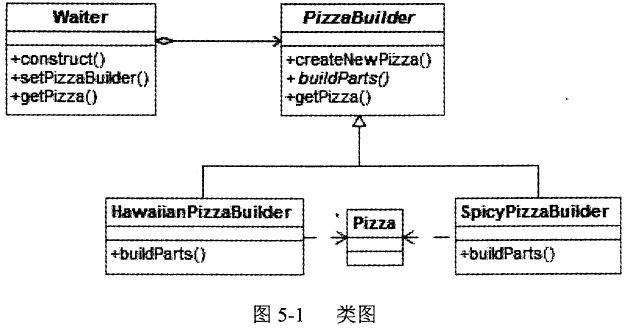
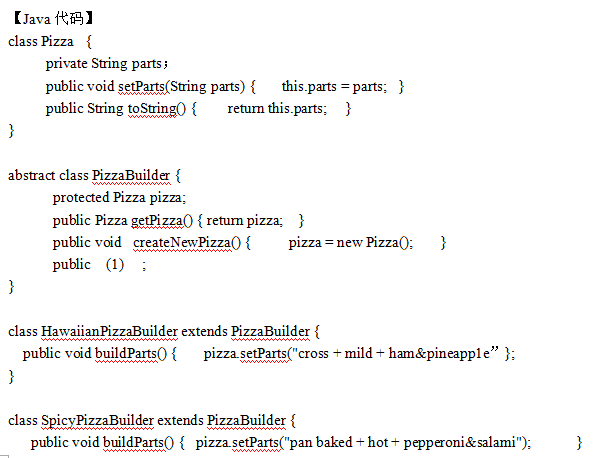
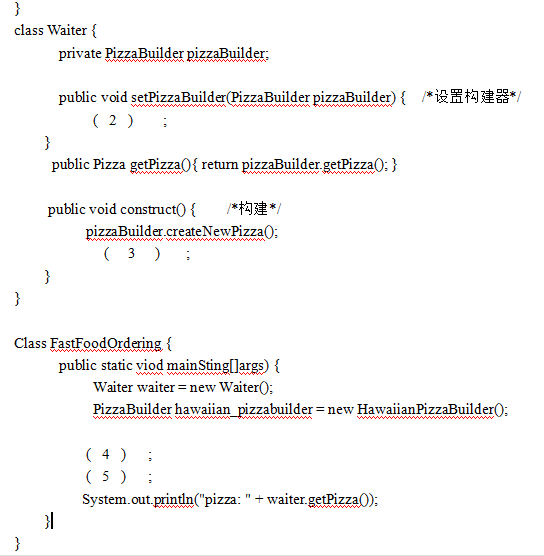
 答案:解析:
答案:解析: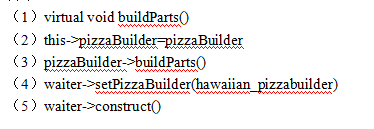
-
第4题:
阅读下列函数说明和C函数,将应填入(n)处的字句写在对应栏内。
[说明]
二叉树的二叉链表存储结构描述如下:
lypedef struct BiTNode
{ datatype data;
street BiTNode *lchiht, *rchild; /*左右孩子指针*/ } BiTNode, *BiTree;
下列函数基于上述存储结构,实现了二叉树的几项基本操作:
(1) BiTree Creale(elemtype x, BiTree lbt, BiTree rbt):建立并返回生成一棵以x为根结点的数据域值,以lbt和rbt为左右子树的二叉树;
(2) BiTree InsertL(BiTree bt, elemtype x, BiTree parent):在二叉树bt中结点parent的左子树插入结点数据元素x;
(3) BiTree DeleteL(BiTree bt, BiTree parent):在二叉树bt中删除结点parent的左子树,删除成功时返回根结点指针,否则返回空指针;
(4) frceAll(BiTree p):释放二叉树全体结点空间。
[函数]
BiTree Create(elemtype x, BiTree lbt, BiTree rbt) { BiTree p;
if ((p = (BiTNode *)malloc(sizeof(BiTNode)))= =NULL) return NULL;
p->data=x;
p->lchild=lbt;
p->rchild=rbt;
(1);
}
BiTree InsertL(BiTree bt, elemtype x,BiTree parent)
{ BiTree p;
if (parent= =NULL) return NULL;
if ((p=(BiTNode *)malloc(sizeof(BiTNode)))= =NULL) return NULL;
p->data=x;
p->lchild= (2);
p->rchild= (2);
if(parent->lchild= =NULL) (3);
else{
p->lchild=(4);
parent->lchild=p;
}
return bt;
}
BiTree DeleteL(BiTree bt, BiTree parent)
{ BiTree p;
if (parent= =NULL||parent->lchild= =NULL) return NULL;
p= parent->lchild;
parent->lchild=NULL;
freeAll((5));
return bt;
正确答案:(1) return p (2) NULL (3) parent->lchild=p (4) parent->lchild (5) p
(1) return p (2) NULL (3) parent->lchild=p (4) parent->lchild (5) p 解析:(1)此处应返回新建的二叉树;(2)新元素结点初始化时,数据域取值x,左右孩子指针指向NULL;
(3)若parent结点的左孩子结点空,则直接令其左孩子指针指向p;
(4)若parent结点的左孩子结点不空,则让新结点p充当其左子树的根;
(5)此处需释放二叉树p(parent的左子树)所占用的空间。 -
第5题:
试题三(共 15 分)
阅读以下说明和 C 程序,将应填入 (n) 处的字句写在答题纸的对应栏内。
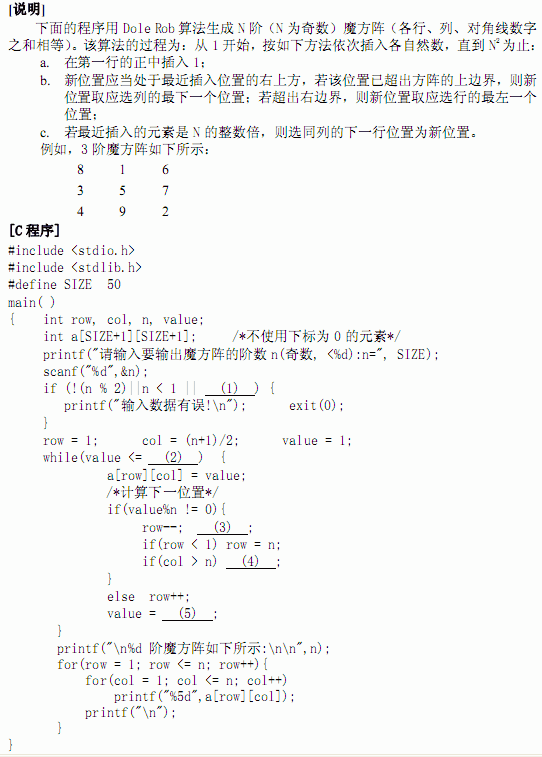 正确答案:
正确答案: